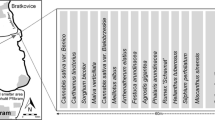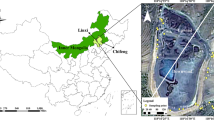Abstract
Phytoremediation is an in situ, cost-effective potential strategy for cleanup of sites contaminated with trace metals. Selection of plant materials is an important factor for successful field phytoremediation. A field experiment was carried out to evaluate the phytoextraction abilities of six high biomass plants (Vertiveria zizanioides, Dianthus chinensis, Rumex K-1 (Rumex upatientia × R. timschmicus), Rumex crispus, and two populations of Rumex acetosa) in comparison to metal hyperaccumulators (Viola baoshanensis, Sedum alfredii). The paddy fields used in the experiment were contaminated with Pb, Zn, and Cd. Our results indicated that V. baoshanensis accumulated 28 mg kg−1 Cd and S. alfredii accumulated 6,279 mg kg−1 Zn (dry weight) in shoots, with bioconcentration factors up to 4.8 and 6.3, respectively. The resulting total extractions of V. baoshanensis and S. alfredii were 0.17 kg ha−1 for Cd and 32.7 kg ha−1 for Zn, respectively, with one harvest without any treatment. The phytoextraction rates of V. baoshanensis and S. alfredii for Cd and Zn were 0.88 and 1.15%, respectively. Among the high biomass plants, R. crispus extracted Zn and Cd of 26.8 and 0.16 kg ha−1, respectively, with one harvest without any treatment, so it could be a candidate species for phytoextraction of Cd and Zn from soil. No plants were proved to have the ability to phytoextract Pb with high efficiency.


Similar content being viewed by others
References
Allen, S. E. (1989). Chemical analysis of ecological materials (2nd edn.). Oxford: Blackwell.
Baker, A. J. M., McGrath, S. P., Reeves, R. D., & Smith, J. A. C. (2000). Metal hyperaccumulator plants: A review of the ecology and physiology of a biological resource for phytoremediation of metal-polluted soils. In N. Terry & Q. Banuelos (Eds.), Phytoremediation of contaminated soil and water (pp. 85–197). Boca Raton, FL: Lewis.
Baker, A. J. M., McGrath, S. P., Sidoli, C. M. D., & Reeves, R. D. (1994). The possibility of in situ heavy metal decontamination of polluted soils using crops of metal-accumulating crops. Resources Conservation and Recycling, 11, 41–49.
Blaylock, M. J., Salt, D. E., Dushenkov, S., Zakharova, O., Gussman, C., Kapulnik, Y., et al. (1997). Enhanced accumulation of Pb in Indian mustard by soil-applied chelating agents. Environmental Science & Technology, 31, 860–865.
Chaney, R. L., Li, Y. M., Brown, S. L., Homer, F. A., Malik, M., Angle, J. S., et al. (2000). Improving metal hyperaccumulator wild plants to develop commercial phytoextraction systems: Approaches and progress. In N. Terry, G. Banuelos, & J. Vangronsveld (Eds.), Phytoremediation of contaminated soil and water (pp. 129–158). , Boca Raton, Washington DC: Lewis.
Chen, H., & Cutright, T. (2001). EDTA and HEDTA effects on Cd, Cr, and Ni uptake by Helianthus annuus. Chemosphere, 45, 21–28.
Copper, E. M., Sims, J. T., Cunningham, S. D., Huang, J. W., & Berti, W. R. (1999). Chelate-assisted phytoextraction of lead from contaminated soil. Journal of Environmental Quality, 28, 1709–1719.
Cui, Y. S., Wang, Q. R., Dong, Y. T., Li, H. F., & Christie, P. (2004). Enhanced uptake of soil Pb and Zn by Indian mustard and winter wheat following combined soil application of elemental sulphur and EDTA. Plant Soil, 261, 181–188.
Ebbs, S. D., Lasat, M. M., Brady, D. J., Cornish, J., Gordon, R., & Kochian, L. V. (1997). Phytoextraction of cadmium and zinc from a contaminated soil. Journal of Environmental Quality, 26, 1424–1430.
Escarré, J., Lefebre, C., Gruber, W., LeBlanc, M., Lepart, J., Riviere, Y., et al. (2000). Zinc and cadmium hyperaccumulation by Thlaspi caerulescens from metalliferous and nonmetalliferous sites in Mediteranean area: Implications for phytoremediation. New Phytologist, 145, 429–437.
Ghosh, M. & Singh, S. P. (2005). A comparative study of cadmium phytoextraction by accumulator and weed species. Environmental Pollution, 133, 365–371.
Hammer, D., & Keller, C. (2003). Phytoextraction of Cd and Zn with Thlaspi caerulescens in field trials. Soil Use and Management, 19, 144–149.
Huang, J. W., Chen, J., Berti, W. B., & Cunningham, S. D. (1997). Phytoremediation of lead-contaminated soils: Role of synthetic chelates in lead phytoextraction. Environmental Science & Technology, 31, 800–805.
Hulina, N., & Dumija, L. (1995). Heavy metals in the weeds of Posavina. Poljoprivredna Znanstvena Smotra, 60, 95–103.
Liphadzi, M. S., Kirkham, M. B., Mankin, K. R., & Paulsen, G. M. (2003). EDTA-assisted heavy-metal uptake by poplar and sunflower grown at a long-term sewage-sludge farm. Plant Soil, 257, 171–182.
McGrath, S. P., Dunham, S. J., & Correll, R. L. (2000). Potential for phytoextraction of zinc and cadmium from soils using hyperaccumulator plants. In N. Terry, G. Banuelos, & J. Vangronsveld (Eds.), Phytoremediation of contaminated soil and water (pp. 109–128). Boca Raton, USA: Lewis.
McGrath, S. P., Lombi, E., Gray, C. W., Caille, N., Dunham, S. J., & Zhao, F. J. (2006). Field evaluation of Cd and Zn phytoextraction potential by the hyperaccumulators Thlaspi caerulescens and Arabidopsis halleri. Environmental Pollution, 141, 115–125.
McGrath, S. P., & Zhao, F. J. (2003). Phytoextraction of metals and metalloids from contaminated soils. Current Opinion in Biotechnology, 14, 277–282.
Meers, E., Ruttens, A., Hopgood, M., Lesage, E., & Tack, F. M. G. (2005). Potential of Brassic rapa, Cannabis sativa, Helianthus annuus and Zea mays for phytoextraction of heavy metals from calcareous dredged sediment derived soils. Chemosphere, 61, 561–572.
Mertens, J., Luyssaert, S., & Verheyen, K. (2005). Use and abuse of trace metal concentrations in plant tissue for biomonitoring and phytoextraction. Environmental Pollution, 138, 1–4.
Nowack, B., Schulin, R., & Robinson, B. (2006). Critical assessment of chelant-enhanced metal phytoextraction. Environmental Science & Technology, 40, 5225–5232.
Page, A. L., Miller, R. H., & Keener, D. R. (1982). Methods of soil analysis. Part 2, Chemical and microbiological properties (2nd ed.), Agronomy No. 9. Madison, Wisconsin: American Society of Agronomy and Soil Science Society of America.
Robinson, B. H., Leblanc, M., Petit, D., Brooks, R. R., Kirkman, J. H., & Gregg, P. E. H. (1998). The potential of Thlaspi caerulescens for phytoremediation of contaminated soils. Plant Soil, 203, 47–56.
Salt, D. E., Blaylock, M., Kumar, P. B. A. N., Dushenkov, V., Ensley, B. D., Chet, I., et al. (1995). Phytoremediation: A novel strategy for the removal of toxic metals from the environment using plants. Biotechnology, 13, 468–474.
Shu, W. S., Ye, Z. H., Lan, C. Y., Zhang, Z. Q., & Wong, M. H. (2001). Acidification of lead/zinc mine tailings and its effect on heavy metal mobility. Environment International, 26, 389–394.
Solhi, M., Shareatmadari, H., & Hajabbasi, M. A. (2005). Lead and zinc extraction potential of two common crop plants, helianthus annuus and Brassica napus. Water Air and Soil Pollution, 167, 59–71.
Szabó, L., & Fodor, L. (2006). Uptake of microelements by crops grown on heavy metal-amended soil. Communications in Soil Science and Plant Analysis, 37, 2679–2689.
Turgut, C., Pepe, M. K., & Cutright, T. J. (2004). The effect of EDTA and citric acid on phytoremediation of Cd, Cr, and Ni from soil using Helianthus annuus. Environmental Pollution, 131, 147–154.
Vervaekea, P., Luyssaerta, S., Mertensa, J., Meersb, E., Tackb, F. M. G., & Lusta, N. (2003). Phytoremediation prospects of willow stands on contaminated sediment: A field trial. Environmental Pollution, 126, 275–282.
Wenzel, W. W., Unterbrunner, R., Sommer, P., & Sacco, P. (2003). Chelate-assisted phytoextraction using canola (Brassica napus L.) in outdoors pot and lysimeter experiments. Plant Soil, 249, 83–96.
Zhao, F. J., Lombi, E., & McGrath, S. P. (2003). Assessing the potential for zinc and cadmium phytoremediation with the hyperaccumulator Thlaspi caerulescens. Plant Soil, 249, 37–43.
Zhuang, P., Ye, Z. H., Lan, C. Y., Xie, Z. W., & Shu, W. S. (2005). Chemically assisted phytoextraction of heavy metals contaminated soils using three plant species. Plant Soil, 276, 153–162.
Acknowledgements
This work was supported by the National ‘‘863’’ Project of China (no. 2001AA645010-3) and the National Natural Science Foundation of China (no. 40471117 and no. 30100024), and Fok Ying Tung Education Foundation (no. 94022).
Author information
Authors and Affiliations
Corresponding author
Rights and permissions
About this article
Cite this article
Zhuang, P., Yang, Q.W., Wang, H.B. et al. Phytoextraction of Heavy Metals by Eight Plant Species in the Field. Water Air Soil Pollut 184, 235–242 (2007). https://doi.org/10.1007/s11270-007-9412-2
Received:
Accepted:
Published:
Issue Date:
DOI: https://doi.org/10.1007/s11270-007-9412-2




